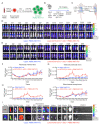Tumor-Localized Administration of α-GalCer to Recruit Invariant Natural Killer T Cells and Enhance Their Antitumor Activity against Solid Tumors
- PMID: 35886891
- PMCID: PMC9317565
- DOI: 10.3390/ijms23147547
Tumor-Localized Administration of α-GalCer to Recruit Invariant Natural Killer T Cells and Enhance Their Antitumor Activity against Solid Tumors
Abstract
Invariant natural killer T (iNKT) cells have the capacity to mount potent anti-tumor reactivity and have therefore become a focus in the development of cell-based immunotherapy. iNKT cells attack tumor cells using multiple mechanisms with a high efficacy; however, their clinical application has been limited because of their low numbers in cancer patients and difficulties in infiltrating solid tumors. In this study, we aimed to overcome these critical limitations by using α-GalCer, a synthetic glycolipid ligand specifically activating iNKT cells, to recruit iNKT to solid tumors. By adoptively transferring human iNKT cells into tumor-bearing humanized NSG mice and administering a single dose of tumor-localized α-GalCer, we demonstrated the rapid recruitment of human iNKT cells into solid tumors in as little as one day and a significantly enhanced tumor killing ability. Using firefly luciferase-labeled iNKT cells, we monitored the tissue biodistribution and pharmacokinetics/pharmacodynamics (PK/PD) of human iNKT cells in tumor-bearing NSG mice. Collectively, these preclinical studies demonstrate the promise of an αGC-driven iNKT cell-based immunotherapy to target solid tumors with higher efficacy and precision.
Keywords: CD1d; bioluminescence live animal imaging (BLI); cancer immunotherapy; invariant natural killer T (iNKT) cell; lung cancer; melanoma; solid tumor; α-GalCer.
Conflict of interest statement
Lili Yang is a scientific advisor to AlzChem and Amberstone Biosciences, as well as a co-founder, stockholder, and advisory board member of Appia Bio. None of the declared companies contributed to or directed any of the research reported in this article. The remaining authors declare no competing interests.
Figures





References
MeSH terms
Substances
Grants and funding
LinkOut - more resources
Full Text Sources
Medical

